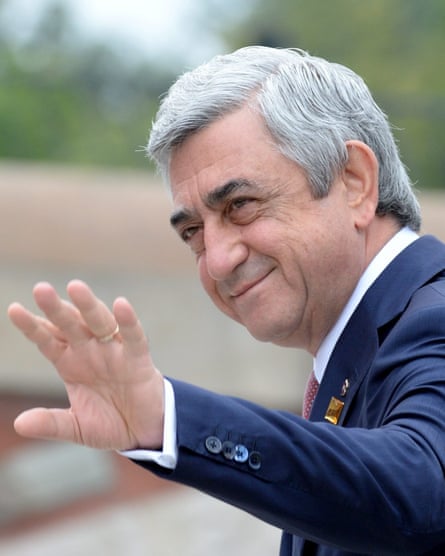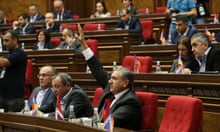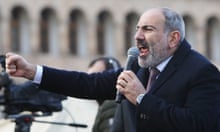For 11 days, the opposition pressure mounted against Serzh Sargsyan, Armenia’s most powerful politician. But few expected he would go so quietly.
Sargsyan, the country’s prime minister and former president for a decade, resigned suddenly on Monday in a stunning concession to the country’s opposition, which had filled the former Soviet republic’s main square with tens of thousands of demonstrators demanding his exit.
Facing a renewed wave of thousands of demonstrators, including deserting soldiers, Sargsyan issued a stark mea culpa on Monday. “I was wrong,” he said in a statement on his government’s website. And he resigned.
Residents of the capital, Yerevan, poured out on the streets to celebrate. “The street movement is against my tenure. I am fulfilling your demand,” his statement said.
Hundreds of uniformed soldiers had joined anti-government demonstrators earlier on Monday in the 11th consecutive day of protests.
The demonstrations were sparked by Sargsyan’s decision to take on the post of prime minister after serving for more than a decade as the country’s president, provoking anger among opposition parties and other protest groups.
The decision came as his second term as president came to an end, and shortly after the constitution was amended to give more power to the prime minister and transform the presidency into a ceremonial role.
The triumph for the protest movement sent shockwaves through the region on Monday, but appeared unlikely to garner intervention.
Russia, a powerful regional actor which has tried to avert revolutions in neighbouring states in the past, appeared to accept Sargsyan’s resignation. The Kremlin said it would not involve itself in the country’s internal politics.
Prior to Sargsyan’s resignation, and apparently yielding to opposition pressure, police released Nikol Pashinyan, a protest leader and opposition MP who had been arrested alongside hundreds of demonstrators on Sunday. Until his release, Pashinyan’s whereabouts had been unknown.
“Nikol! Nikol!” chanted protesters draped in Armenian flags as they marched in Yerevan. Tens of thousands of protesters had gathered in the city’s Republic Square at the weekend in one of the country’s largest demonstrations in years.

“This is the last time I will speak to you as the head of the government,” Sargsyan said in an extraordinary statement. “Nikol Pashinyan was right. I was wrong.”
Sargsyan’s attempted move to the prime minister’s office earned comparisons to the return of Vladimir Putin to the presidency in 2012, after spending four years as Russia’s prime minister. Putin too faced opposition demonstrations, but managed to survive them.
In Armenia, the outrage over Sargsyan’s return gained a foothold, with political opponents uniting with civil activists to maintain pressure on the government.
On the 10th day of protests, they coaxed Sargsyan into negotiations with the opposition at a hotel in Yerevan. “I came here to discuss your resignation,” Pashinyan told Sargsyan shortly before negotiations broke down on Sunday. Pashinyan was arrested shortly afterwards.
On Monday striking students, defying threats from police to stay away, blocked streets in Yerevan, with dozens of soldiers joining demonstrators, according to videos posted on social media. The soldiers appeared to be unarmed.
The defence ministry warned earlier on Monday that the soldiers, who it said were members of a unit deployed as peacekeepers, would be punished harshly for participating in the protests.
After hundreds of arrests on Sunday it appeared that Armenia’s protests could end in a bloody crackdown. But by Monday afternoon, Sargsyan’s resolve appeared to have collapsed. Pashinyan was released in the early afternoon and Sargsyan’s resignation statement came hours later.
“The situation that has been created has a few solutions, but I am not part of any of them,” Sargsyan said. “I will leave my post as the country’s prime minister.” It was an admission of guilt so frank, it seemed out of place in modern politics.
The defence minister warned that Armenia’s foe Azerbaijan was benefiting from the unrest. “The enemy is looking at events in our country. Instability inside our country opens a road for them to take action. We need to tell society about this,” Vigen Sarkisian said. He said the army could only become involved if a state of emergency was declared, which he hoped would not happen “for years to come”.
A shrewd former military officer, Sargsyan was first elected as president of the impoverished Moscow-allied country in 2008. After that poll, 10 people died in clashes between police and supporters of the defeated opposition candidate. He was re-elected in 2013, with his second and final term ending on 9 April.








